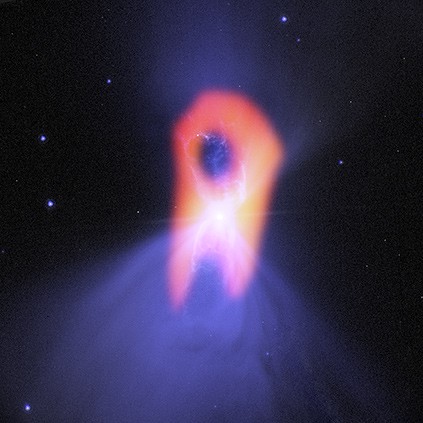
 Inhabitants of Minneapolis, Chicago, and St. Louis may be thinking that the American Midwest is the coldest place in the Universe. Well, almost, but not quite.
Inhabitants of Minneapolis, Chicago, and St. Louis may be thinking that the American Midwest is the coldest place in the Universe. Well, almost, but not quite.
At a cosmologically crisp one degree Kelvin (minus 458 degrees Fahrenheit), the Boomerang Nebula in the constellation Centaurus is actually the coldest known object in the Universe—colder, in fact, than the faint afterglow of the Big Bang, which, at minus 455 degrees Fahrenheit, is the natural background temperature of space.
Astronomers using the Atacama Large Millimeter/submillimeter Array (ALMA) telescope in Chile have taken a new look at this intriguing object to learn more about its frigid properties and determine its true shape, which has an eerily ghost-like appearance.
The ALMA telescope array observes the Universe in a relatively unexplored region of the spectrum between infrared light and radio waves.
As originally observed with ground-based telescopes, this nebula appeared lopsided, which is how it got its name. Later observations with the Hubble Space Telescope revealed a bow-tie-like structure. The new ALMA data, however, reveal that the Hubble image tells only part of the story, and the twin lobes seen in that image may actually be a trick of the light as seen at visible wavelengths.
“This ultra-cold object is extremely intriguing and we’re learning much more about its true nature with ALMA,” said Raghvendra Sahai, a researcher and principal scientist at NASA’s Jet Propulsion Laboratory in Pasadena, California, and lead author of a paper published in the Astrophysical Journal. “What seemed like a double lobe, or ‘boomerang’ shape, from Earth-based optical telescopes, is actually a much broader structure that is expanding rapidly into space.”
The Boomerang Nebula, located about 5,000 light-years away, is a relatively young example of an object known as a planetary nebula. Planetary nebulae, contrary to their name, are actually the end-of-life phases of stars like our Sun that have sloughed off their outer layers. What remains at their centers are white dwarf stars, which emit intense ultraviolet radiation that causes the gas in the nebulae to glow and emit light in brilliant colors.
The Boomerang is a pre-planetary nebula, representing the stage in a star’s life immediately preceding the planetary nebula phase, when the central star is not yet hot enough to emit sufficient ultraviolet radiation to produce the characteristic glow. At this stage, the nebula is seen by starlight reflecting off its dust grains.
The outflow of gas from this particular star is expanding rapidly and cooling itself in the process. This is similar in principle to the way refrigerators use expanding gas to produce cold temperatures. The researchers were able to take the temperature of the gas in the nebula by seeing how it absorbed the cosmic microwave background radiation, which has a very uniform temperature of 2.8 degrees Kelvin (minus 455 degrees Fahrenheit).
ALMA, an international astronomy facility, is a partnership of Europe, North America and East Asia in cooperation with the Republic of Chile. ALMA construction and operations are led on behalf of Europe by the European Southern Observatory (ESO), on behalf of North America by the National Radio Astronomy Observatory (NRAO), and on behalf of East Asia by the National Astronomical Observatory of Japan (NAOJ). The Joint ALMA Observatory (JAO) provides the unified leadership and management of the construction, commissioning and operation of ALMA.


Be the first to comment